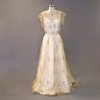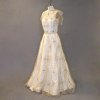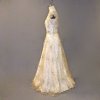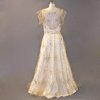DaisyandStella
VFG Member
Hi all,
I have a vintage evening dress that i'm a little baffled by.
It has a crepe-back satin under dress reminiscent of the late 1930s with a side metal zipper.
Over top of that is a taffeta over dress also with a side metal zipper.
There is a horsehair? trimmed web design that covers the entire dress with prong-set rhinestone accents.
There are no labels.
I know that metal zippers didn't appear until the late 1930s and it was still rare for a 30s dress to have a metal zipper. I am curious as to what everyone thinks for dating on this. Also, I would like to try to hand wash as the taffeta over layer has some very faint pink markings, but i'm afraid to ruin the dress.
Any thoughts would be greatly appreciated on dating and cleaning.
Thanks much!
I have a vintage evening dress that i'm a little baffled by.
It has a crepe-back satin under dress reminiscent of the late 1930s with a side metal zipper.
Over top of that is a taffeta over dress also with a side metal zipper.
There is a horsehair? trimmed web design that covers the entire dress with prong-set rhinestone accents.
There are no labels.
I know that metal zippers didn't appear until the late 1930s and it was still rare for a 30s dress to have a metal zipper. I am curious as to what everyone thinks for dating on this. Also, I would like to try to hand wash as the taffeta over layer has some very faint pink markings, but i'm afraid to ruin the dress.
Any thoughts would be greatly appreciated on dating and cleaning.
Thanks much!







